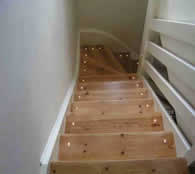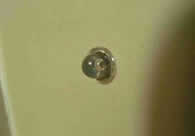This was an effective, yet very affordable project to add lighting to a staircase. It was possible to locate the light source centrally below the stairs, which meant that the fibre runs were relatively short, and our customer Paul G opted to use inexpensive 0.75mm and 1mm fibre with a 75 watt light source. So, the cost of the fibre optic components was less than £250.
Paul opted to upgrade his light source to include a separate power supply to the colour wheel motor. This allows him to turn the motor on and off, which means that individual static colours can be selected. So, one night the lights can be blue, and the next night red or white, for instance. The high gloss finish of the skirting and bannister rails creates additional reflected points of light.


We’d probably have recommended using 1mm or even 1.5mm fibres, but Paul decided that he wanted two different types of lighting – one for the risers and one for the treads, and looking at the photos it’s hard to be critical of his choice.
“I would have preferred to use the 1mm fibres with the lenses and the 0.75mm fibres for the bare ends,” he explained, “but my 1mm drill bit was just too short to go right through the thickness of the stairs, so I had to step up a size to a 1.5mm bit for the holes. The stair backs (risers) are just the original hardboard which had been very poorly fitted, and sheets of Porcelain Glow Formica (which was a bitch to cut)!! These sheets were then glued in place using standard PVA glue.
“I can confirm that this method is far easier than trying to wire numerous LEDs and you don’t have the problem of trying to remove and match up individual lights when they fail. Another plus with fibre optics is that they have a far greater colour spectrum than LEDs.”


